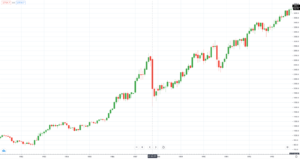Ring in the New Year With Dazzling Total Lunar Eclipse of a Supermoon
The celestial show will be visible on the East Coast around 12:12 a.m. on January 21, 2019
January’s so-called “super blood wolf moon” promises to be supercharged: While Ryan F. Mandelbaum of Gizmodo (in a very spirited denunciation) breaks down why the nickname is a pseudoscientific masterpiece, the sight it describes—a total lunar eclipse of a supermoon, which will find the moon enveloped in copper and reddish hues around 12:12 a.m. EST on January 21—will certainly be worth standing out in the frigid night air to see.
Simply put, total lunar eclipses occur when the sun, the Earth and the moon reach perfect alignment, causing Earth’s shadow to hide the moon from view. Comparatively, NASA notes, a total solar eclipse occurs when the moon lands in between the Earth and sun, blocking light from reaching the planet and enveloping the sun in darkness. (In August 2017, North America experienced its first total solar eclipse in nearly a century.)
Lunar eclipses take the form of total, partial or penumbral events. As Robert Roy Britt of Space.com, explains, they can only happen during full moons; in a partial lunar eclipse, Earth’s shadow only covers part of the moon, lending it the appearance of a just-bitten apple. In a penumbral lunar eclipse, not much happens—at least from the point of view of someone watching from Earth. As Sky & Telescope statement puts it, the event is “essentially a tease,” briefly coating the moon in a dusky yet subtle shading.
Total lunar eclipses are the rarest of the three varieties; CNN’s Andrea Diaz writes that January’s will be the first to hit the United States in three years. Not only does a total lunar eclipse make the moon appear to be a slightly larger “supermoon,” but it also gives the moon its unique coloring.
A blood moon simply refers to the eerie blood-red hue the moon appears to take on during a total eclipse. The hue is the result of light from the sun traveling through Earth’s atmosphere and bending toward the moon. As Space.com’s Britt notes, red, as the color at the far end of the visible light spectrum (think of the childhood mnemonic device Roy G. Biv), can pass through the atmosphere more easily than other colors, which tend to get blocked and scattered. The result, NASA scientist Noah Petro tells Space.com’s Doris Elin Salazar, is the color of all of Earth’s sunrises and sunsets simultaneously reaching the moon.
Interestingly, astronomer Pamela Gay further explains to Salazar that lunar eclipses serve as a direct reflection of our world. “A blood colored moon is created [by] ash from fires and volcanoes, … dust storms and pollution all filtering sunlight as it scatters around our world,” she says. “A grey eclipse is clear skies. Our world can change the appearance of another world, and during an eclipse, the universe lets us see this color play.”
The upcoming total lunar eclipse will take place over several hours between January 20 and 21, 2019. It will be visible from North and South America, as well as portions of western Europe and Africa. Totality, or the moment the moon is completely eclipsed, is set to take place around 12:12 a.m. EST, but plan on beginning your stargazing adventure an hour or so if you’re hoping to witness a partial eclipse, too.
Even if you’re not an avid astronomer, it’s worth tuning in: As Alex Hider reports for WXYZ Detroit, the next total lunar eclipse won’t circle back to the U.S. until May 2021.
Article Source : https://www.smithsonianmag.com/smart-news/ring-new-year-dazzling-supermoon-180971137/
















